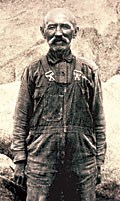|
Even before the California Gold Rush of 1849, prospectors were finding gold in southern California. As the take from the mines in the Sierras petered out, miners fanned out into the deserts. Here hot summers, scarce water, limited wood sources, and the difficulty and high cost of transporting equipment and provisions created a challenging environment in which to operate a mine. But a few hardy adventurers persevered and about 300 mines were developed in what is now Joshua Tree National Park—although few were good producers. An exception is the Lost Horse Mine, which produced more than 10,000 ounces of gold and 16,000 ounces of silver (worth approximately $5 million today) between 1894 and 1931. When the story of the Lost Horse Mine is told, it sounds like a western campfire tale: gun slinging cowboys, cattle rustlers, horse thieves, the lure of gold, and a sticky-fingered miner. 
Johnny Lang One night, while camped in the Lost Horse Valley, the Langs’s horses disappeared. Next morning Johnny tracked them to the McHaney brothers’ camp near today’s Keys Ranch. According to local legend, the McHaney Gang were cattle rustlers. Keys said they told Johnny his horses weren’t there and to leave the area. Keys goes on to say that Johnny met up with a man named “Dutch” Frank who told of also being threatened by the McHaneys. Frank said that he had discovered a rich claim but was afraid to develop it. Johnny and his father bought the rights to the mine for $1000 and called it Lost Horse. To reduce the chances of being killed by the McHaney Gang or having his claim jumped, Johnny took on three partners. After filing their claim, they set up a two-stamp mill and began processing gold. J.D. Ryan Getting to the Gold The amalgam of mercury and gold was smelted to separate the two metals. The mercury could be reused and the gold was formed into bricks. These bricks were carried to Banning every week, concealed in a 16-horse freight wagon. The 130-mile trip to deliver the gold and return with supplies took five days. As the story goes, the day shift was producing an amalgam the size of a baseball while the night shift, supervised by Lang, recovered a mere golf ball. Ryan hired a detective to investigate and discovered that when Johnny removed the amalgam from the copper plates, he kept half for himself. Ryan gave Lang a choice: sell out or go to jail. Lang sold, then moved into a nearby canyon where he continued to prospect. The Lost Horse Mine continued producing until 1905, when the miners hit a fault line and forever lost the ore-bearing vein. The mine was leased to others or left dormant until 1931, when rising gold prices prompted the processing of 600 tons of tailings (unprocessed chunks of leftover ore) with cyanide, producing a few hundred ounces of gold. During one of the mine’s dormant phases, Lang returned and set up residence in the cookhouse. According to Keys, Lang had hidden his stolen amalgam at the mill site and, unable to get to it before Ryan ran him off, had returned to retrieve his stash. Lang sold what Keys called “pure gold bullion” on several occasions during this time. In the winter of 1925, sickly and unable to walk out for help, Johnny Lang died of exposure along Keys View Road. Two months later, Keys found his body and buried him across from the access road to the mine. National Park Service “Puffing” the Mine Lost Horse Mine Hike by Museum Curator Melanie Spoo |
Last updated: April 22, 2024
